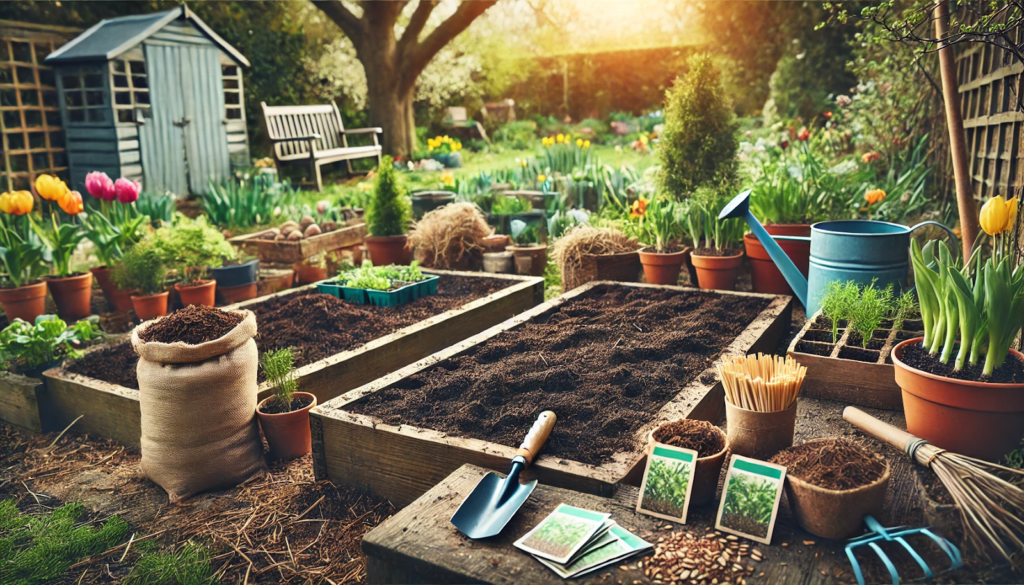Spring is the most exciting time for gardeners. It’s when everything comes back to life—and the success of your season depends on the steps you take before planting. Preparing your garden properly in late winter or early spring ensures healthier plants, better yields, and less work later on.
This guide outlines exactly what to do before putting seeds or seedlings in the ground. From cleaning up winter debris to improving your soil, these tips will help you make the most of your growing season.
1. Start with a Cleanup
After winter, your garden will likely be covered in leaves, dead plants, and other debris.
What to do:
- Remove dead foliage, stems, and fallen branches
- Pull up any annuals left from last year
- Rake up leaves and mulch them or add to compost
- Check for weeds that may have taken root over winter
Tip: Leave a few undisturbed areas for overwintering pollinators, especially if you’re early in the season.
2. Test and Amend Your Soil
Healthy soil is the foundation of a successful garden. Before planting, it’s a good idea to test your soil and improve its quality.
Steps:
- Use a soil test kit or send a sample to a local extension service
- Check pH, nitrogen, phosphorus, and potassium levels
- Add compost to increase organic matter and improve texture
- Adjust pH with lime (to raise) or sulfur (to lower), if needed
- Mix in aged manure, worm castings, or natural amendments like bone meal or rock phosphate
3. Plan Your Garden Layout
Taking time to organize your space will save you effort later.
Planning tips:
- Rotate crops from where they were last year
- Group plants with similar water and sunlight needs
- Leave room for paths, supports, or trellises
- Consider companion planting to naturally boost plant health
Draw a simple sketch or use a garden planning app to visualize your layout.
4. Prepare Garden Beds
Once the soil is ready and the ground is no longer frozen or waterlogged, prep your beds for planting.
How to prepare:
- Loosen the soil with a garden fork or tiller
- Remove remaining weeds and roots
- Rake the surface smooth and level
- Edge the beds to prevent grass or weeds from creeping in
Raised beds can be topped off with fresh soil and compost mix.
5. Organize Tools and Supplies
Having your tools ready makes your gardening process more efficient.
Essentials to check:
- Trowels, spades, and hand forks
- Watering cans and hoses
- Plant labels or markers
- Seed trays or pots
- Gardening gloves
- Sharpen and clean all tools before first use
Stock up early on fertilizer, organic pest control, and any trellising materials.
6. Start Seeds Indoors
Some crops need a head start before they go into the garden.
Best vegetables to start indoors:
- Tomatoes
- Peppers
- Eggplant
- Broccoli
- Cabbage
- Herbs like basil or parsley
Use seed-starting mix and containers with drainage, and place them under grow lights or near a sunny window.
7. Harden Off Seedlings
Before transplanting seedlings into your garden, they need to adjust to outdoor conditions gradually.
How to harden off:
- Start 7 to 10 days before transplanting
- Place seedlings outside in a sheltered spot for a few hours daily
- Increase their time outdoors each day
- Bring them in at night or during harsh weather
This helps prevent transplant shock and encourages stronger growth.
8. Set Up Supports and Infrastructure
It’s easier to install garden structures now before plants start growing.
Examples:
- Trellises for peas, cucumbers, and beans
- Tomato cages or stakes
- Row covers for early crops
- Drip irrigation systems or soaker hoses
- Raised bed irrigation layouts
Installing early avoids damaging young plants later.
9. Mulch Early
While many gardeners wait until plants are established, mulching early helps control weeds and retain moisture from the start.
Use:
- Straw or hay (seed-free)
- Shredded leaves
- Compost or bark chips
Apply mulch after the soil has warmed slightly, but before weeds get a chance to spread.
10. Prepare for Pests Naturally
Get ahead of pest issues before they arise.
Tips:
- Install insect netting or row covers
- Attract beneficial insects with companion plants like dill or marigold
- Use organic repellents like neem oil or diatomaceous earth
- Remove overwintering pest habitats (old leaves, stems, debris)
Monitor daily once plants are in the ground.
Final Thoughts: A Good Start Leads to Great Results
Preparing your garden for spring planting is one of the most important steps of the entire growing season. By taking the time to clean, enrich, organize, and plan now, you’ll create the conditions for a healthy, abundant garden all year long.
Whether you’re growing vegetables, herbs, or flowers, success begins before the first seed is sown.






